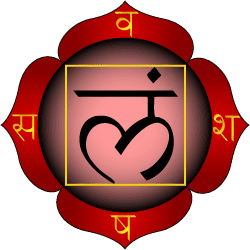Harmonizing Your Spirit: Exploring the Healing Sounds of the Chakras

In the gentle whisper of the wind, the rustling leaves, and the rhythmic waves of the ocean, nature hums an ancient tune. This cosmic symphony aligns with the vibrational essence of our own being. Within our bodies, there are seven major energy centers, known as chakras, each resonating with a specific sound. Chanting these sounds can help us connect deeply with each chakra, promoting healing and spiritual awakening. Let’s embark on a journey through each chakra, exploring the unique vibrations and practices to bring awareness and balance to these vital aspects of our life and self.
The Root Chakra: LAM (LUHM)
The Root Chakra, or Muladhara, is the foundation of our energy system. Located at the base of the spine, it governs our sense of security, grounding, and basic survival instincts. The sound associated with the Root Chakra is “LAM” (pronounced LUHM).
Experience: Find a quiet space where you can sit comfortably, preferably on the ground. Close your eyes and take a few deep breaths. Imagine roots extending from your body deep into the earth, anchoring you firmly. Begin chanting “LAM” slowly and deeply. Feel the vibration travel down your spine and into the ground beneath you. With each chant, visualize your Root Chakra glowing a vibrant red, pulsating with strength and stability.
Mindfulness: As you chant, be mindful of your thoughts and feelings related to security and stability. Notice any fears or anxieties that arise and acknowledge them without judgment. Reflect on ways to cultivate a sense of safety and groundedness in your daily life, such as spending time in nature, practicing mindfulness, or establishing routines that provide a sense of structure and support.
The Sacral Chakra: VAM (VUHM)
The Sacral Chakra, or Svadhisthana, is situated just below the navel. It is the center of our emotions, creativity, and sensuality. The sound for this chakra is “VAM” (pronounced VUHM).
Experience: Sit comfortably and close your eyes. Take deep breaths, focusing on the area just below your navel. Begin chanting “VAM” in a steady, rhythmic manner. Feel the vibration in your lower abdomen, awakening your creative and emotional energies. Visualize an orange light swirling in this area, growing brighter with each chant.
Mindfulness: Pay attention to your creative expressions and emotional responses. Are there areas where you feel blocked or suppressed? Use the chanting practice to release these blocks and allow your creative energies to flow freely. Engage in activities that inspire you, whether it’s painting, dancing, writing, or any form of artistic expression that resonates with your soul.
The Solar Plexus Chakra: RAM (RUHM)
The Solar Plexus Chakra, or Manipura, located above the navel, is the seat of our personal power, confidence, and self-discipline. The sound associated with this chakra is “RAM” (pronounced RUHM).
Experience: Sit comfortably with your hands resting on your upper abdomen. Close your eyes and take deep, steady breaths. Begin chanting “RAM,” feeling the vibration in your solar plexus. Visualize a bright yellow sun radiating warmth and power in this area. With each chant, imagine this sun growing stronger, filling you with confidence and vitality.
Mindfulness: Reflect on your sense of personal power and self-esteem. Are there areas in your life where you feel disempowered or lack confidence? Use the chanting practice to boost your self-worth and assertiveness. Set small, achievable goals to strengthen your sense of discipline and accomplishment.
The Heart Chakra: YAM (YUM)
The Heart Chakra, or Anahata, located at the center of the chest, is the bridge between the physical and spiritual realms. It governs love, compassion, and emotional balance. The sound for the Heart Chakra is “YAM” (pronounced YUM).
Experience: Sit comfortably and place your hands over your heart. Close your eyes and breathe deeply, focusing on your heart center. Begin chanting “YAM,” feeling the gentle vibration in your chest. Visualize a vibrant green light emanating from your heart, expanding with each chant to envelop your entire being in love and compassion.
Mindfulness: Consider your relationships and your capacity for love and compassion. Are there wounds or resentments that need healing? Use the chanting practice to cultivate forgiveness and empathy, both for yourself and others. Engage in acts of kindness and compassion, and allow yourself to receive love from those around you.
The Throat Chakra: HAM (HUM)
The Throat Chakra, or Vishuddha, located at the throat, is the center of communication, self-expression, and truth. The sound associated with this chakra is “HAM” (pronounced HUM).
Experience: Sit comfortably and place your hands gently on your throat. Close your eyes and take deep breaths, focusing on your throat area. Begin chanting “HAM,” feeling the vibration in your throat. Visualize a bright blue light swirling in this area, clearing away any blockages. With each chant, imagine this light growing stronger, enhancing your ability to communicate and express your truth.
Mindfulness: Reflect on your communication skills and your ability to express yourself authentically. Are there truths you are holding back or difficulties in speaking up? Use the chanting practice to clear any blockages and strengthen your voice. Practice honest and open communication in your interactions, and explore creative ways to express yourself, such as writing or singing.
The Third Eye Chakra: OM (OHM)
The Third Eye Chakra, or Ajna, located between the eyebrows, is the center of intuition, insight, and spiritual awareness. The sound for this chakra is “OM” (pronounced OHM).
Experience: Sit comfortably and close your eyes, focusing on the space between your eyebrows. Take deep, steady breaths. Begin chanting “OM,” feeling the vibration resonate throughout your head. Visualize a deep indigo light in your third eye area, growing brighter with each chant. Allow this light to expand, opening your mind to higher wisdom and clarity.
Mindfulness: Consider your intuitive abilities and your connection to your inner wisdom. Are there areas where you feel disconnected or uncertain? Use the chanting practice to enhance your intuition and spiritual insight. Spend time in meditation, journaling, or other reflective practices that help you tune into your inner guidance.
The Crown Chakra: AH (AAH)
The Crown Chakra, or Sahasrara, located at the top of the head, is the gateway to our connection with the divine and our higher self. The sound associated with this chakra is “AH” (pronounced AAH).
Experience: Sit comfortably and close your eyes, focusing on the top of your head. Take deep, calming breaths. Begin chanting “AH,” feeling the vibration at the crown of your head. Visualize a brilliant violet or white light emanating from your crown, connecting you to the divine source. With each chant, imagine this light growing stronger, filling you with a sense of peace and unity with the universe.
Mindfulness: Reflect on your spiritual beliefs and your connection to the divine. Are there aspects of your spirituality that need nurturing or exploration? Use the chanting practice to deepen your spiritual connection and sense of oneness. Engage in spiritual practices that resonate with you, such as prayer, meditation, or spending time in nature.
Integrating Chakra Chanting into Daily Life
Chanting the sounds of the chakras is a powerful tool for self-awareness and healing. By integrating these practices into your daily routine, you can create a harmonious balance within your energy system. Here are some practical steps to incorporate chakra chanting into your life:
- Morning Ritual: Begin your day with a short chanting session. Choose one chakra to focus on each day of the week, allowing yourself to connect deeply with each aspect of your being over time.
- Mindful Breaks: Take a few moments during your day to chant the sound of a specific chakra, especially if you feel imbalanced or stressed. This can help realign your energy and bring you back to a state of calm and focus.
- Evening Reflection: End your day with a chanting practice to release any accumulated tension and promote restful sleep. Reflect on your experiences and any insights gained through the practice.
- Group Practice: Chanting with others can amplify the vibrational energy and create a sense of community and shared intention. Join a meditation group or invite friends to chant with you.
By dedicating time to these practices, you honor your spiritual journey and cultivate a deeper connection with your true self. Remember, the power of these sounds lies not just in the chanting itself, but in the mindful awareness and intention you bring to each practice. Allow the vibrations to guide you towards greater harmony, healing, and spiritual awakening.






Responses